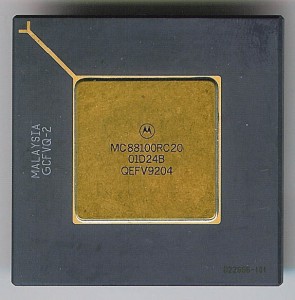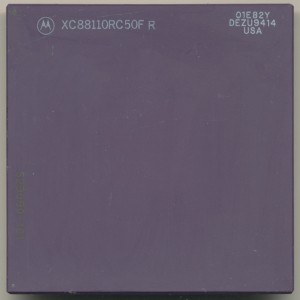CPU of the Day: Motorola XC88110 88000 RISC Processor
In the late 1980’s Motorola was developing a full 32-bit RISC processor from the ground up. Initially called the 78000, it was renamed the 88000. The first implementation of the 88000 Instruction Set Architecture was the 88100. It included a FPU and integer unit but required a separate chip (the 88200 CMMU) for caching and memory management. Typically 2 of the 88200s were required (one for instruction cache, one for data, 16kb of cache each). A 64lb cache was also available called the 88204. Made on a 1.5u process the 88100 contained 165,000 transistors while the CMMU chips contained 750,000. Each chip dissipated 1.5Watts at 25MHz. Prices in 1989 were $494 for the CPU and $619 each for the CMMUs. A complete system of 3 chips would be nearly $2000. Not exactly competitive pricing.
The initial, and biggest, customers for the 88000 were to be Apple, and Ford Motor Company, an unusual combination to say the least. Apple invested in the 88000 to be the replacement for the 680×0 processors it had been using. Ford was looking to replace the Intel 8061 processors (from which the MCS-96 MCUs were developed) that had run their EEC-IV engine computers since the early 1980’s. Motorola (as well as Toshiba) had been second sourcing these for Ford for sometime. Ford based its choice on the 88100 based ECU on the assumption that Apples adoption of the 88100 would guarantee good software and compiler support. If Apple stuck with it that is..
In the early 1990’s IBM approached Apple to form a partnership to develop the POWER architecture into what is now known as PowerPC. Apple decided to switch from the 88100 to the PowerPC and dropped their plans for the 88100 leaving Ford as the sole large customer. When Motorola joined the AIM alliance (Apple IBM Motorola) which was to develop the PowerPC, Ford was offered a PowerPC solution instead of the now dying 88000. Ford adopted the PowerPC in its next line of ECU’s (the EEC-V).
Motorola attempted to remedy the 88100’s problems with the release of the 88110. The 88110 included the MMU on chip, cutting component and board costs significantly. The 88110 added several more execution units as well (another Integer, a separate multiply, divide, bit,and 2 pixel type units). The addition of the graphics capabilities makes the 88110 somewhat comparable to Intel’s i860 processor. Both were superscalar designs of over 1 million transistors, running at around 50MHz. Both supported graphics processing, and both were rather unsuccessful. The 88110 contained 1.5 million transistors and was made on a 3-layer 1 micron process. It contained on chip 8kb instruction and data caches (previous handled by a pair of 88200s). The 88110 supported up to a 1MB L2 cache via the 88410. THe 88110 was a good design, it just had no customers, and without volume customers. prices stayed high, and adoption low, the catch-22 of processor adoption.
By 1997 the 88110 had been discontinued, while the 88100/200 were still available, for $190 and $274 each respectively (for the fastest 33MHz parts). The 88100 was officially declared end of life by Motorola in January 1998, though it had been dead long before.




April 7th, 2013 at 5:16 pm
[…] CPU of the Day: Motorola XC88110 88000 RISC Processor […]
August 29th, 2013 at 3:58 pm
88200’s were not required to build a complete system with the 88100, and in fact NCD made a fairly popular X terminal back in the day with only a single 88100. As I recall, technically, you could also build a system with 1 (or 3) 88200’s, though I’m not sure why you would.
August 29th, 2013 at 4:09 pm
Ahh yah, just was part of the Motorola ‘design’ but no real reason you could not implement their functionality on your own, or use without.
Thanks for the info.
January 12th, 2018 at 10:20 pm
NeXT was going to use the 88100 or 88110 in a RISC workstation, but it hadn’t reached production by the time NeXT stopped making hardware.
I think it was going to have dual CPUs. Also, it’s been reported that NeXT saw how things were headed for the 88k and switched to the PowerPC.
There may be a functioning prototype somewhere at Apple. Not sure if it was running on 88k or PowerPC.
December 20th, 2018 at 1:43 pm
The first 88000 CPUs were shipping around when the original NeXT Computer shipped, so availability wasn’t the issue; NeXT just bet on 68K way too long.
The NeXT RISC Workstation was originally slated to use two 88110s, but NeXT switched to two PowerPC 601s along with most of Motorola’s 88K customers. (The ones who didn’t switch to Intel anyway, like Data General.)
From what I understand, the NRW was virtually ready to ship when NeXT cancelled hardware, and a small number have been seen running.
December 20th, 2018 at 1:53 pm
Thanks for the info, always interesting to think what would have been if it succeeded (well more then I did)
October 19th, 2021 at 1:23 am
I worked at Apple Computer during the 80’s-90’s; lastly in VG5 in the RISC CPU group. We were designing an 88100 Mac like nothing seen before, starting in about 1989. This Mac was like a multiprocessor minicomputer. It used a proprietary Apple RISC I/O processor chip called Mazda with its RISC engine Wankel to soft load the 88110 ROM code into SDRAM, which was a whopping 128 bits wide! I was the Diagnostics Manager that created the bring up strategy and created/managed the team to bring up the machine. My main piece of this was to create the system architecture for the bring up, to create the 88110 software environment needed to allow us to download and run 88110 based tests from a controlling Macintosh. I wrote all the 88110 assembly code using the Diab Compiler/Assembler under Mac Workshop. I brought up the 88110, working closely with Motorola. BTW, this Mac, code named Jaguar and later Tesseract also had a high performance Apple designed Graphics Processor.
As we all know now, eventually the 88110 was abandoned for the PPC 601. What most people don’t know, is that to make the hardware transition from 88110 to 601 much easier, the 88110 bus interface was used for the 601 to keep CPU interface changes to a minimum.
The 88110 came up well for me, but had several serious early bugs eg caches not working. IMHO, the worst bug I found was that it could not return properly from an interrupt due to the 88110 improperly stacking and unshackling registers.
Steven Cox (Former Apple and Motorola CPU Engineer)
March 8th, 2022 at 3:22 am
I have a Quadra 950 with an 88000 processor card installed. No software. I find Steven Cox’s story fascinating and wonder if there is an opportunity to obtain any Apple software that could bring the 88000 card back to life?